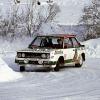
The origins of Donington Park (UK)
#1

Posted 13 January 2004 - 13:07
“Donington Park in 1931 was owned by a Mr.Shields who used to open the park to the public for the price of 6d. Fred Craner, a local garage owner and motorcycle racer, was looking for somewhere local to compete, and he came to an agreement with the landowner to hold a race on a dirt track in the grounds. The first meeting was held on Whit Monday, May 1931, on a 2 mile 327yd circuit.
For 1932 the track was improved, and a combined motorcycle and sidecar meeting was held. For 1933, the track was widened and tarmacked, and the first car meeting was held on the 25th March, followed by a further three car meetings that year. The track was extended for 1934, and by 1935 the circuit was 2 miles 971 yds long, and was established enough to hold the first Donington Grand Prix. The race was won by Richard Shuttleworth in an Alfa Romeo.
For 1937 the circuit was extended again to 3 miles 220 yds, with the circuit being extended down the Melbourne Hill to the Melbourne Corner, which was situated just over the county border in Derbyshire! This version was used to hold the famous Third Donington Grand Prix, won by Bernd Rosemeyer in 3h1m22s in a Mercedes-Benz W125. However, the war soon intervened, and the circuit was requisitioned by the military to store vehicles.
Although attempts were made to reopen the circuit, none were successful until the grounds were purchased by the self-made millionaire Tom Wheatcroft. It wasn't easy reopening the circuit due to the protrusion of the circuit into the neighbouring county, so racing was restricted to the 1.957 mile national circuit which missed out the Melbourne loop and was modified from the 1937 circuit (some of the corners were reprofiled and moved, and the some of the corners were renamed).
Wheatcroft harboured the desire of holding another Grand Prix at the circuit, so in 1985 he extended the circuit length to 2.5 miles by extending the circuit with the Shields Straight and the Melbourne Hairpin. On the 22nd September 1985 the circuit hosted the F3000 championship, and in 1989 the World Sports-Prototype Championship. Wheatcroft's dream finally came true on the 11th April 1993 when the circuit hosted the European Grand Prix, famously won by Ayrton Senna. However, the race was only hosted once.”
I wonder if the knowledgeable TNF crew can enlighten me a bit about the background to all this. I have done a search of the Forum but cannot find any thread on this.
For instance, who funded what must have been a very expensive project, especially in the midst of the Great Depression? Was it just Craner and Shields?
With the exception of a few bits such as Starkeys bridge, this must have been a pretty impressive modern facility by the standards of the time. How was it viewed by the racing establishment in the 1930s – was it an upstart, working-class venue, an enemy to the Brooklands crowd?
How come it was chosen for those British GPs instead of Brooklands, or weren’t the Surrey mob much interested in GP racing?
The bit above tells us who Craner (of the Curves fame) was, but who was Starkey and why did he have a bridge – and what was the bridge for?
I would be delighted to learn a bit more.
Advertisement
#2

Posted 13 January 2004 - 16:08
The 4 Donington (NOT British) GPs were organized & promoted by Derby & District Motor Club,& the circuit owners. Brooklands as you say was only interested in motorsport as a amateur activity for 'gentlemen' As to Donington being 'an impressive modern facility'for the time I don't think such a thing existed. All they had to do was to lay out some tarmac and some straw bales & post & wire fences to hold the crowd back.
#3

Posted 13 January 2004 - 16:29
Thanks for that - I checked up and £12,000 in 1933 is apparently worth £672,256.53 today. I doubt if you would get much of a race track for that much today though! I guess labour costs were a lot lower back then.Originally posted by Rob29
The total cost of laying out the original 1933 car circuit was £12,000.
#4

Posted 13 January 2004 - 16:46
Hm, try Auto-Union C-Type instead..Originally posted by BRG
the famous Third Donington Grand Prix, won by Bernd Rosemeyer in 3h1m22s in a Mercedes-Benz W125.
#5

Posted 13 January 2004 - 17:43
Now I am wondering how much of the rest of that piece about Donington is wrong!
#6

Posted 14 January 2004 - 08:11
#7

Posted 14 January 2004 - 10:04
Originally posted by BRG
The bit above tells us who Craner (of the Curves fame) was, but who was Starkey and why did he have a bridge – and what was the bridge for?
Not sure who Starkey was, but I assume the bridge was part of the estate road system before the track was built. Its strange though as it doesn't appear to cross a river - and the valley it crosses isn't that deep, maybe it was just a "folly".
It was cut in half for the modern track but you can see where the track went through in the surviving section, the old track is part of the perimeter road there.
You can see it and other parts of the old track on this aerial photo:-
Link to satellite photo
Still a pretty substantial stone bridge though, as Nigel Mansell found out when he spun into it in his dramatic attempt at touring car racing post-F1 retirement!
- Michael
#8

Posted 14 January 2004 - 11:54











